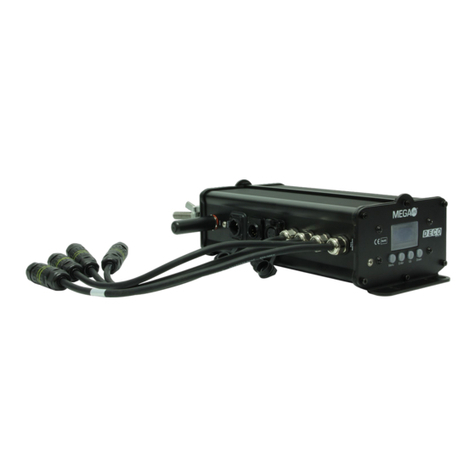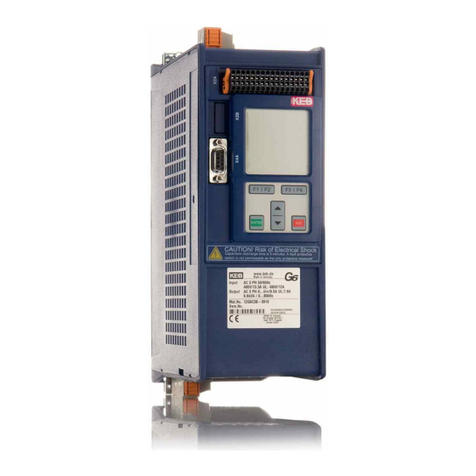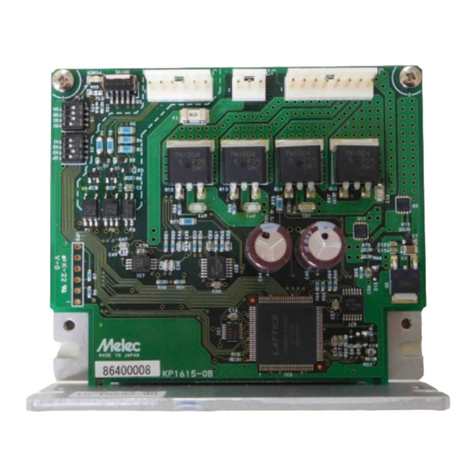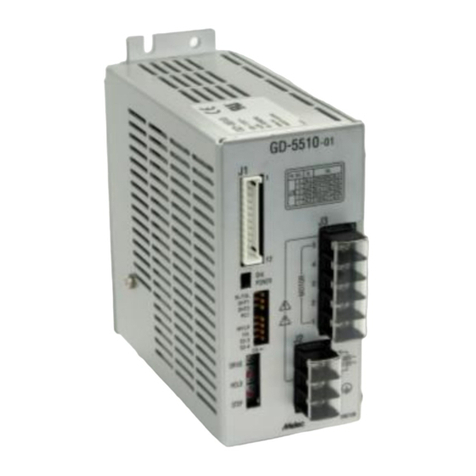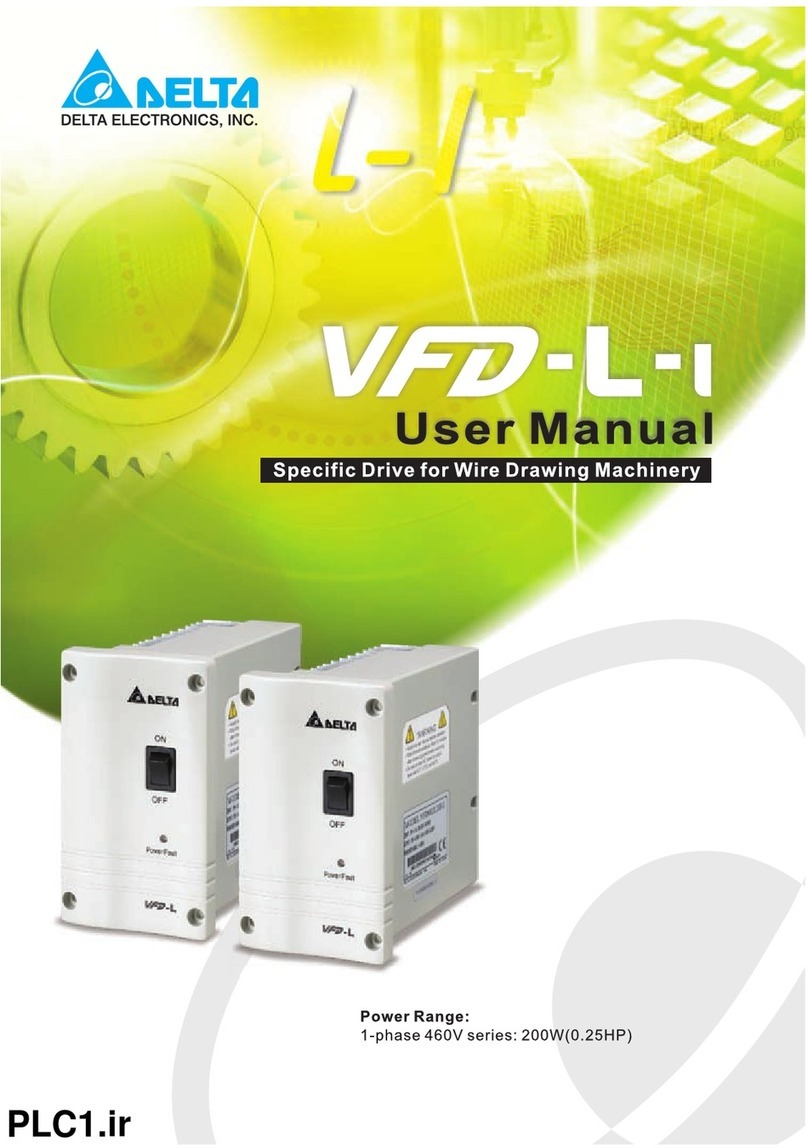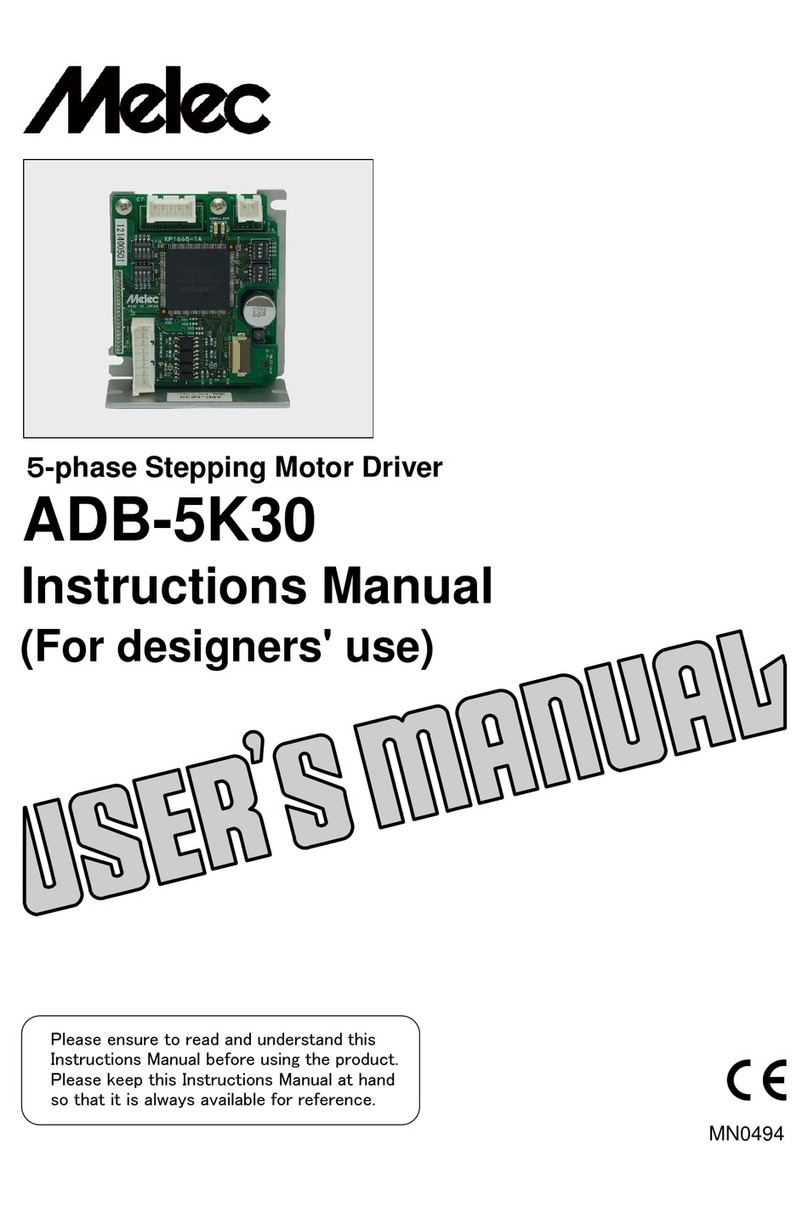Boston gear BETAplus Matrix Owner's manual

Boston Gear®
Ratiotrol®
DC Motor Speed Control
Doc. No. 57766
Beta Plus Series
Single Phase
1/6-3 HP
Installation and Operation

Inside Front Cover
BLANK

SECTION TITLE PAGE
WARNINGS........................................................................................................... 3
I GENERAL INFORMATION............................................................................ 5
Introduction................................................................................................................. 5
General Description .................................................................................................... 5
Model Matrix .............................................................................................................. 5
Motor Selection .......................................................................................................... 5
II INSTALLATION .................................................................................................. 6
Installation Guidelines ................................................................................................ 6
Installing The Controller............................................................................................. 7
Initial Startup ............................................................................................................ 16
III OPERATION........................................................................................................ 17
Power On/Off............................................................................................................ 17
Run............................................................................................................................ 17
Stop ........................................................................................................................... 17
Speed Control ........................................................................................................... 18
Jog.............................................................................................................................18
Reverse ..................................................................................................................... 18
Inoperative Motor ..................................................................................................... 18
IV MAINTENANCE AND REPAIR.................................................................. 19
General...................................................................................................................... 19
Adjustment Instructions............................................................................................ 19
Acceleration.............................................................................................................. 19
Deceleration.............................................................................................................. 19
IR Compensation ...................................................................................................... 19
Maximum Speed Armature Feedback ...................................................................... 20
Maximum Speed Tachometer Feedback .................................................................. 20
Minimum Speed........................................................................................................ 20
Offset ........................................................................................................................ 21
Current Limit ............................................................................................................ 21
Troubleshooting........................................................................................................ 22
V PARTS LIST......................................................................................................... 25
VI RATINGS AND SPECIFICATIONS............................................................ 26
Ratings ...................................................................................................................... 26
Operating Conditions................................................................................................ 27
Performance Characteristics ..................................................................................... 27
Adjustments .............................................................................................................. 28
Specifications............................................................................................................ 28
VII DRAWINGS......................................................................................................... 31
1
Table of Contents
BETAplus

LIST OF TABLES
TABLE TITLE PAGE
1 BETAplus Model Matrix............................................................................................ 5
2 Jumper J4 Positions .................................................................................................... 8
3 Initial Potentiometer Settings ................................................................................... 16
4 Dynamic Braking Characteristics ............................................................................. 17
5 Troubleshooting................................................................................................... 22-24
6 Parts List, BETAplus Controllers ............................................................................. 25
7 Typical Application Data.......................................................................................... 26
8 Operating Voltages And Signals .............................................................................. 26
9 Controller Weights.................................................................................................... 27
10 Speed Regulation Characteristics ............................................................................. 27
11 Dip Switch S3 Settings ............................................................................................. 29
12 Shunt Field Data ....................................................................................................... 29
LIST OF ILLUSTRATIONS
FIGURE TITLE PAGE
1 Controller Mounting Configurations .......................................................................... 9
2 Controller Mounting Dimensions ............................................................................... 9
3 Logic Connection Diagram, Run-Stop-Jog Switch, 1/6 - 2 HP................................ 10
4 Logic Connection Diagram, Forward-Reverse Switch
And Run-Stop-Jog Switch, 1/6 - 2 HP................................................................. 10
5 Logic Connection Diagram, Run-Stop Pushbuttons
And Run-Jog Switch, 1/6 - 3 HP ......................................................................... 11
6 Logic Connection Diagram, Optional Armature
Contactor Reversing Using Switches, 1/6 - 3 HP ................................................ 11
7 Logic Connection Diagram, Optional Armature Contactor Reversing
Using Pushbuttons And Run-Jog Switch, 1/6 - 3 HP .......................................... 12
8 Logic Connection Diagram, Line Starting With
Motor Speed Potentiometer, 1/6 - 3 HP............................................................... 12
9 Signal Connection Diagram, Motor Speed Potentiometer ....................................... 13
10 Signal Connection Diagram, Tachometer Feedback ................................................ 13
11 Signal Connection Diagram, Current (Torque) Reference Potentiometer................ 13
12 Signal Connection Diagram, Line Starting Without
A Motor Speed Potentiometer ............................................................................. 14
13 Signal Connection Diagram, 4 - 20 mA Interface .................................................... 14
14 Signal Connection Diagram, 2-Wire Transducer ..................................................... 14
15 Signal Connection Diagram, 4 - 20 mA Transducer With Manual/Auto Switch..... 15
16 Signal Connection Diagram, 0 - 10 VDC External Speed Reference Signal ........... 15
17 Functional Schematic ............................................................................................... 31
18 Schematic, 1/6 - 3 HP ............................................................................................... 32
19 BETAplus Control Board, 1/6 - 3 HP....................................................................... 33
2
Table of Contents (continued)
BETAplus

WARNINGS
The Following Safety Precautions Must Be Strictly Adhered To At All Times.
1. YOU AS THE OWNER OR OPERATOR OF BOSTON GEAR EQUIPMENT HAVE THE
RESPONSIBILITY TO HAVE THE USERS OF THIS EQUIPMENT TRAINED IN ITS OPERATIONS
AND WARNED OF ANY POTENTIAL HAZARDS OF SERIOUS INJURY.
2. THE DRIVE EQUIPMENT SHOULD BE INSTALLED, OPERATED, ADJUSTED, AND SERVICED
ONLY BY QUALIFIED PERSONNEL FAMILIAR WITH THE CONSTRUCTION AND OPERATION OF
THE EQUIPMENT AND THE HAZARDS INVOLVED INCLUDING THOSE DESCRIBED BELOW.
FAILURE TO OBSERVE THIS PRECAUTION CAN RESULT IN PERSONAL INJURY, LOSS OF LIFE,
AND PROPERTY DAMAGE.
3. THE NATIONAL ELECTRICAL CODE REQUIRES THAT AN AC LINE FUSED DISCONNECT OR
CIRCUIT BREAKER BE PROVIDED IN THE AC INPUT POWER LINES TO THE CONTROLLER.
THIS DISCONNECT MUST BE LOCATED WITHIN SIGHT OF THE CONTROLLER. DO NOT
OPERATE THE CONTROLLER UNTIL THIS CODE REQUIREMENT HAS BEEN MET.
4. THE DRIVE EQUIPMENT IS AT AC LINE VOLTAGE WHENEVER AC POWER IS CONNECTED TO
THE DRIVE EQUIPMENT. CONTACT WITH AN ELECTRICAL CONDUCTOR INSIDE THE DRIVE
EQUIPMENT OR AC LINE DISCONNECT CAN CAUSE ELECTRIC SHOCK RESULTING IN
PERSONAL INJURY OR LOSS OF LIFE.
5. BE SURE ALL AC POWER IS DISCONNECTED FROM THE DRIVE EQUIPMENT BEFORE
TOUCHING ANY COMPONENT, WIRING, TERMINAL, OR ELECTRICAL CONNECTION IN THE
DRIVE EQUIPMENT.
6. ALWAYS WEAR SAFETY GLASSES WHEN WORKING ON THE DRIVE EQUIPMENT.
7. DO NOT REMOVE OR INSERT CIRCUIT BOARDS, WIRES, OR CABLES WHILE AC POWER IS
APPLIED TO THE DRIVE EQUIPMENT. FAILURE TO OBSERVE THIS PRECAUTION CAN CAUSE
DRIVE DAMAGE AND PERSONAL INJURY.
8. ALL DRIVE EQUIPMENT ENCLOSURES, MOTOR FRAMES, AND REMOTE OPERATOR STATIONS
MUST BE CONNECTED TO AN UNBROKEN COMMON GROUND CONDUCTOR. AN UNBROKEN
GROUNDING CONDUCTOR MUST BE RUN FROM THE COMMON GROUND CONDUCTOR TO A
GROUNDING ELECTRODE BURIED IN THE EARTH OR ATTACHED TO A PLANT GROUND.
REFER TO THE NATIONAL ELECTRICAL CODE AND LOCAL CODES FOR GROUNDING
REQUIREMENTS.
3
BETAplus

INTRODUCTION
This manual contains installation, operation, and maintenance and repair instructions for Boston BETAplus Single-
Phase Adjustable-Speed DC Motor Controllers. A parts list, ratings, specifications, and drawings are included.
GENERAL DESCRIPTION
BETAplus Controllers statically convert AC line power to regulated DC for nonregenerative, adjustable-speed
armature control of shunt-wound and permanent-magnet motors.
BETAplus Controllers comply with applicable standards established by the National Electrical Code and NEMA for
motor and industrial control equipment. The controllers are Underwriters Laboratories Listed (File No. E60207) and
CSA approved (File No. LR19781).
Table 1. BETAplus MODEL MATRIX
* Includes Armature Contactor.
† Units are reconnectable
MOTOR SELECTION
BETAplus Controllers control the operation of general purpose DC motors designed for use with solid-state rectified
power supplies. The motors may be shunt-wound, stabilized shunt-wound, or permanent magnet. For maximum
efficiency, any motor should be rated for operation from a NEMA Code K power supply.
5
Section I – General Information
BETAplus
Line Voltage †Construction Function Operator’s
HP Range Controls
Open Enclosed Run/ Run/ Arm. Arm. Cont. Local Remote
Item Cat. Chassis Stop Stop Switch Rev. (Integral)
Code No. 115 VAC 230 VAC D.B.* Rev. W/D.B.*
64874 RBS2 X X X
64875 RBS2B X X X
64876 RBS2S X X X
64877 RBS2R X X X
64878 RBS2M 1/6 - 1 1/2 - 2 X X X X
64879 RBS2MB X X X X
64965 RBS2MS X X X
64880 RBS2MR X X X
64881 RBS3 1/6 -1 1/2 - 3 XX X
64882 RBS3M X X X X

Before starting the installation, read this section thoroughly. In addition, a thorough review of the Ratings And
Specifications (Section VI) is recommended. The following installation guidelines should be kept in mind when
installing the controller.
INSTALLATION GUIDELINES
1. CONTROLLER MOUNTING – Controllers may be mounted either vertically or horizontally. Never mount the
controller upside down, immediately beside or above heat generating equipment, or directly below water or steam
pipes.
The controller must be mounted in a location free of vibration.
Multiple controllers may be mounted side by side, as close to each other as the mounting feet will allow.
The minimum clearance at the top and bottom of the controller may be as narrow as the conduit fittings allow.
2. ATMOSPHERE – The atmosphere surrounding the controller must be free of combustible vapors, chemical
fumes, oil vapor, and electrically conductive or corrosive materials.
The air surrounding an enclosed controller must not exceed 40 degrees C (104 degrees F), and the air surrounding
an open-chassis controller must not exceed 55 degrees C (131 degrees F). Minimum air temperature is 0 degree C
(32 degrees F) for enclosed and open-chassis controllers.
3. CONTROLLER CONSTRUCTION – Controller bases are made of die-cast aluminum with a powdered epoxy
finish.
Controller enclosures are totally enclosed, nonventilated, and comply with NEMA type 3, 4 and 12 standards.
There is an oil resistant synthetic rubber gasket between the cover and base. Those models with integral operator
controls include flexible boots to seal the switches, and a seal for the MOTOR SPEED potentiometer.
BETAplus enclosure covers are die-cast aluminum alloy.
4. LINE SUPPLY – The controller should not be connected to a line supply capable of supplying more than 100,000
amperes short-circuit current. Short-circuit current can be limited by using an input supply transformer of 50 KVA
or less, or by using correctly sized current limiting fuses in the supply line ahead of the controller. Do not use a
transformer with less than the minimum transformer KVA listed in Table 7, page 26.
If rated line voltage is not available, a line transformer will be required. If the line supply comes directly from a
transformer, place a circuit breaker or disconnect between the transformer secondary and the controller. If power
is switched in the transformer primary, transients may be generated which can damage the controller. See Table 7
(page 26) for minimum transformer KVA.
Do not use power factor correction capacitors on the supply line to the controller.
A 12-joule metal oxide varistor (MOV) is connected across the controller terminals. If higher energy transients are
present on the line supply, additional transient suppression will be required to limit transients to 150% of peak line
voltage.
When a 115 VAC line supply is used, connect the white (common) wire to Terminal L2 and connect the remaining
(hot) wire to Terminal L1.
6
Section II – Installation
BETAplus

5. ISOLATION TRANSFORMER – While not required, an isolation transformer can provide the following
advantages:
a. Reduce the risk of personal injury if high voltage drive circuits are accidentally touched.
b. Provide a barrier to externally generated AC supply transients. This can prevent controller damage from
abnormal line occurrences.
c. Reduce the potential for damaging current if the motor armature, motor field, or motor wiring become
grounded.
6. GROUNDING – Connect the green or bare (ground) wire of the line supply to the ground screw located near the
top conduit entry hole in the controller base. Then ground the controller base by connecting the ground screw to
the earth ground.
The motor frame and operator control stations must also be grounded.
Personal injury may occur if the controller, motor, and operator stations are not properly grounded.
7. WIRING PRACTICES – The power wiring must be sized to comply with the National Electrical Code, CSA, or
local codes. Refer to the controller data label for line and motor current ratings.
Do not use solid wire
Signal wiring refers to wiring for potentiometers, tachometer generators, and transducers. Control wiring refers to
wiring for operator controls. If nonshielded wire is used for signal and control wiring, it may be run in a common
conduit, but not in the same conduit as the power wiring. In an enclosure, nonshielded signal and control wiring
must be kept separated from power wiring and only cross at 90 degree angles.
If shielded wire (such as Alpha 2422 - two conductor, 2423 - three conductor, 2424 - four conductor) is used for
the signal and control wiring, it may be run in the same conduit with the power wiring. Connect the shields to
chassis ground (ground screw on the controller base) and tape the opposite ends of the shields.
Two 3/4-14 NPT threaded holes are provided for conduit entry, one each in the top and bottom of the controller.
INSTALLING THE CONTROLLER
1. Remove the controller front cover (if used) by removing the four cover screws.
2. Check components in the controller for shipping damage. Report shipping damage to the carrier.
3. Check the controller and motor data labels to be sure the units are electrically compatible.
4. Be sure the controller has been calibrated correctly for the motor being used. Calibration is performed by
changing the position of a Jumper (J4) on the controller control board to comply with Table 2, page 8. To
change the position of Jumper J4, pull the jumper from the control board and then push it onto the appropriate
two pins on the board. For the location of J4, see Figure 19 (page 33).
7
BETAplus

TABLE 2. JUMPER J4 POSITIONS
*Select the position closest to the motor nameplate armature current rating.
5. Check the positions of Jumpers J1, J2, and J3 on the control board. For the locations of J1, J2, and J3, see
Figure 19 (page 33). For a 230 VAC line supply and a 180V armature motor, Jumper J1 must be in the 230V
position, and Jumpers J2 and J3 must both be in the 180V position. For a 115 VAC line supply, J1 must be in
the 115V position, and J2 and J3 must be in the 90V positions.
6. The controller may be surfaced mounted or panel mounted as shown in Figure 1, page 9. Mount the
controller. Mounting dimensions are shown in Figure 2, page 9.
7. Conduit entry is made by punching out the knockout at the top or bottom of the controller base. To prevent
component damage from knockout fragments, apply masking tape to the inside of the knockout before
punching.
8. Connect the AC power wiring to Terminals L1 and L2, ground to ground lug, motor armature leads to A1 (+)
and A2 (-), and field leads to F + and F -. Be sure to observe Installation Guidelines 4 and 7 on pages 6 and 7.
If half-wave shunt field voltage is desired, connect the motor shunt field leads to Terminals F+ and F/2.
(Table 12, page 29).
NOTE: Low inductance motors require a full-wave field to prevent instability.
9. If the controller contains any options that require external wiring, follow the wiring instructions in the
instruction sheet supplied with the option.
10. If remote operator control wiring and/or signal wiring is required, connect the controller as shown in the
appropriate connection diagram (Figures 3 through 16). Figures 3 through 8 show operator control
connections, and Figures 9 through 16 show signal connections.
11. Set the DIP Switch (S3) as shown in the appropriate connection diagram. See Figure 19 (page 33) for the
location of DIP Switch S3. Also refer to Table 11, “DIP Switch Settings,” page 29.
12. Replace the controller cover, if used.
8
BETAplus
JUMPER MOTOR ARMATURE CURRENT RATING (AMPERES)*
POSITION 2 HP Maximum 3 HP Maximum
100% 10 15
80% 8 12
60% 6 9
40% 4 6
20% 2 3

FIGURE 1. BETAplus CONTROLLER MOUNTING CONFIGURATIONS
FIGURE 2. MOUNTING DIMENSIONS, BETAplus
9
BETAplus

FIGURE 3. LOGIC CONNECTION DIAGRAM, RUN-STOP-JOG SWITCH, 1/6 - 2 HP
FIGURE 4. LOGIC CONNECTION DIAGRAM, FORWARD-REVERSE SWITCH
AND RUN-STOP-JOG SWITCH, 1/6 - 2 HP
10
BETAplus

FIGURE 5. LOGIC CONNECTION DIAGRAM, RUN-STOP PUSHBUTTONS
AND RUN-JOG SWITCH, 1/6 - 3 HP
FIGURE 6. LOGIC CONNECTION DIAGRAM, OPTIONAL ARMATURE CONTACTOR
REVERSING USING SWITCHES, 1/6 - 3 HP
11
BETAplus

FIGURE 7. LOGIC CONNECTION DIAGRAM, OPTIONAL ARMATURE CONTACTOR
REVERSING USING PUSHBUTTONS AND RUN-JOG SWITCH, 1/6 - 3 HP
FIGURE 8. LOGIC CONNECTION DIAGRAM, LINE STARTING WITH
MOTOR SPEED POTENTIOMETER, 1/6 - 3 HP
12
BETAplus

FIGURE 9. SIGNAL CONNECTION DIAGRAM, MOTOR SPEED POTENTIOMETER
FIGURE 10. SIGNAL CONNECTION DIAGRAM, TACHOMETER FEEDBACK
FIGURE 11. SIGNAL CONNECTION DIAGRAM, CURRENT (TORQUE)
REFERENCE POTENTIOMETER
13
BETAplus

FIGURE 12. SIGNAL CONNECTION DIAGRAM, LINE STARTING
WITHOUT A MOTOR SPEED POTENTIOMETER
FIGURE 13. SIGNAL CONNECTION DIAGRAM, 4 - 20 mA INTERFACE
FIGURE 14. SIGNAL CONNECTION DIAGRAM, 2-WIRE TRANSDUCER
14
BETAplus

FIGURE 15. SIGNAL CONNECTION DIAGRAM, 4 - 20 mA TRANSDUCER
WITH MANUAL/AUTO SWITCH
FIGURE 16. SIGNAL CONNECTION DIAGRAM, 0 - 10 VDC EXTERNAL SPEED REFERENCE SIGNAL
15
BETAplus

INITIAL STARTUP
1. Remove the controller cover (if used) by removing the four cover screws.
2. Be sure all wiring is correct and all connections are tightened securely.
3. Be sure the controller is calibrated correctly. See steps 4 and 5 under “Installing The Controller” on pages 7 and 8.
4. Be sure the AC line voltage to the controller agrees with the controller nameplate.
5. The potentiometers in the controller are factory adjusted as shown in Table 3. These settings will provide
satisfactory operation for most applications. If different settings are required, refer to “Adjustment Instructions”
starting on page 19.
TABLE 3. INITIAL POTENTIOMETER SETTINGS
6. Replace the cover, if required, and secure it with the four cover screws.
7. Switch on the AC supply to the controller.
8. Check motor rotation, as follows:
a. If a MOTOR SPEED potentiometer is used, turn it fully counterclockwise. If an external signal is used for the
speed reference, set is at minimum.
b. If a RUN-STOP-JOG switch is used, place it in RUN position. Otherwise, initiate a RUN command.
c. Turn the MOTOR SPEED potentiometer clockwise or increase the speed reference signal, as applicable. To
stop the motor, place the switch in the STOP position, or initiate a STOP command, as applicable.
If the motor rotates in the wrong direction, disconnect the AC supply to the controller, and then interchange
the motor armature leads at the motor connection box or at the controller terminal board.
9. Refer to Section III, “Operation” for operating instructions.
16
BETAplus
POTENTIOMETER SETTING DESCRIPTION
ACCEL 2/3 Turn Clockwise 8 Seconds
CUR LMT Fully Clockwise (100%) 150% Load
DECEL 2/3 Turn Clockwise 8 Seconds
IR/TACH Fully Counterclockwise (0%) 0% Boost
MAX SPD 3/4 Turn Clockwise 100% Speed
MIN SPD (Offset) Fully Counterclockwise (0%) 0% Speed

POWER ON/OFF
The controller energizes when the AC voltage is supplied to the controller.
NOTE: Whenever the AC supply voltage is applied to the controller, the motor shunt field is energized with rated
voltage, and potentially hazardous voltage is present at the motor armature terminals. These voltages can cause electric
shock resulting in personal injury or loss of life.
RUN
If a RUN-STOP-JOG switch is used, place the switch in RUN position. Otherwise, initiate a RUN command. A RUN
command will accelerate the motor to the setting of the MOTOR SPEED potentiometer or external speed reference
signal, as applicable. The rate of acceleration is preset by the ACCEL potentiometer on the controller control board.
STOP
If a RUN-STOP-JOG switch is used, place the switch in STOP position. Otherwise, initiate a STOP command. A
STOP command will stop the motor at a rate proportional to the stopping rate of the motor load.
If the controller has dynamic braking, the motor stopping time will be reduced. Dynamic braking provides exponential
rate braking of the motor armature, which occurs when the circuit is opened between the controller and the motor
armature, and one or more resistors are connected across the motor armature.
The dynamic braking resistors provide initial braking torque as shown in Table 4.
TABLE 4. DYNAMIC BRAKING CHARACTERISTICS*
*High Intertia Loads may extend braking time and cause overheating of the dynamic braking resistors.
An antiplug feature, present in the armature contactor reversing board, prevents restarting the motor before the motor
has braked to a stop.
17
Section III – Operation
BETAplus
RATED HORSEPOWER
RATED
COMPONENT MODEL VOLTAGE 1/6 1/4 1/3 1/2 3/4 1 1-1/2 2 3
RBS2M 115V 180 129 103 66 44 34 - - -
BRAKING 230V - - - 278 190 130 88 62 -
TORQUE (%) RBS3M 115V 300 215 170 110 75 60 - - -
230V - - - 400 320 220 145 105 85
RBS2M 115V 15 12 11 8 6 2 - - -
STOPS PER 230V - - - 86111-
MINUTE RBS3M 115V 965544- - -
230V - - - 544332

SPEED CONTROL
Motor speed is directly proportional to the setting of the MOTOR SPEED potentiometer or the magnitude of an
external speed reference signal, as applicable. This potentiometer or the speed reference signal may be adjusted while
the motor is running or may be preset before the motor is started.
The rates of acceleration and deceleration are preset by the ACCEL and DECEL potentiometers, respectively, located
on the controller control board.
Maximum speed and minimum speed (or offset) are preset by the MAX SPD and MIN SPD potentiometers,
respectively, located on the control board.
JOG
If a RUN-STOP-JOG switch is used, place the switch in JOG position. Otherwise initiate a JOG command. JOG is
momentary, causing motor rotation only while the switch is held in JOG position or while a JOG command is active.
Release the switch to stop the motor.
Normally, jog speed is at "RUN" speed.
REVERSE
To reverse motor rotation on controllers with reversing capabilities, initiate a STOP function and then initiate a
REVERSE command. The motor will then accelerate to the setting of the MOTOR SPEED potentiometer or external
speed reference signal, as applicable. Forward and reverse speed ranges are identical.
If a FWD-REV switch is used, it must have a center position interlock, which requires a momentary relaxation of
pressure before the opposite position can be engaged. The center position causes a STOP command and allows time for
the motor to stop before a REVERSE command is initiated. If a REVERSE command is initiated while the motor is
rotating, motor and controller damage may occur.
Armature contactor reversing incorporates an anti-plug feature which requires that the motor be stopped before it can
be reversed.
INOPERATIVE MOTOR
If the motor stops and/or won’t start, disconnect the AC power to the controller, remove the controller cover (if used),
and check the AC line fuse on the controller control board. For the location of the fuse, see Figure 19 (page 33). If the
fuse is blown, refer to the Troubleshooting Table (Table 5). Pages 22–24
If the fuse is not blown, the internal overload monitor may have shut down the controller. The overload monitor will
shut down the controller if the motor armature current exceeds 120% of rated for a length of time of continuous
operation. The length of time is determined by the amount of the overload. If the overload monitor trips, reset the
controller by initiating a STOP command, removing the overload, and then initiating a RUN command to restart.
Repeated shutdown indicates an overload condition (mechanical or electrical) which must be removed. Refer to the
Troubleshooting Table (Table 5).
18
BETAplus
Other manuals for BETAplus Matrix
1
Table of contents
Other Boston gear DC Drive manuals
Popular DC Drive manuals by other brands
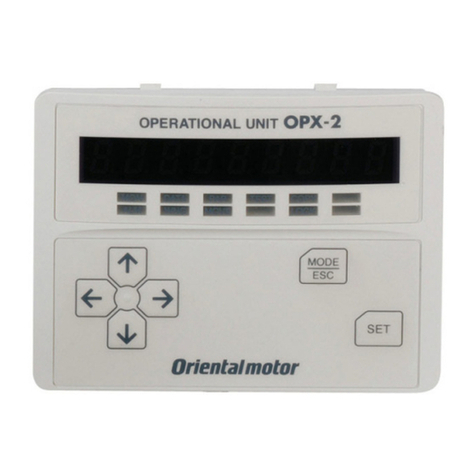
Oriental motor
Oriental motor OPX-2A quick start guide
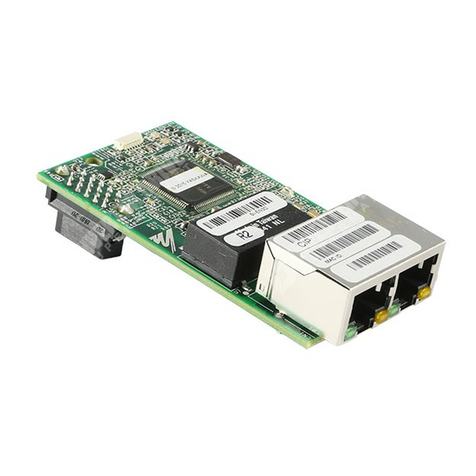
YASKAWA
YASKAWA 1000-Series installation manual
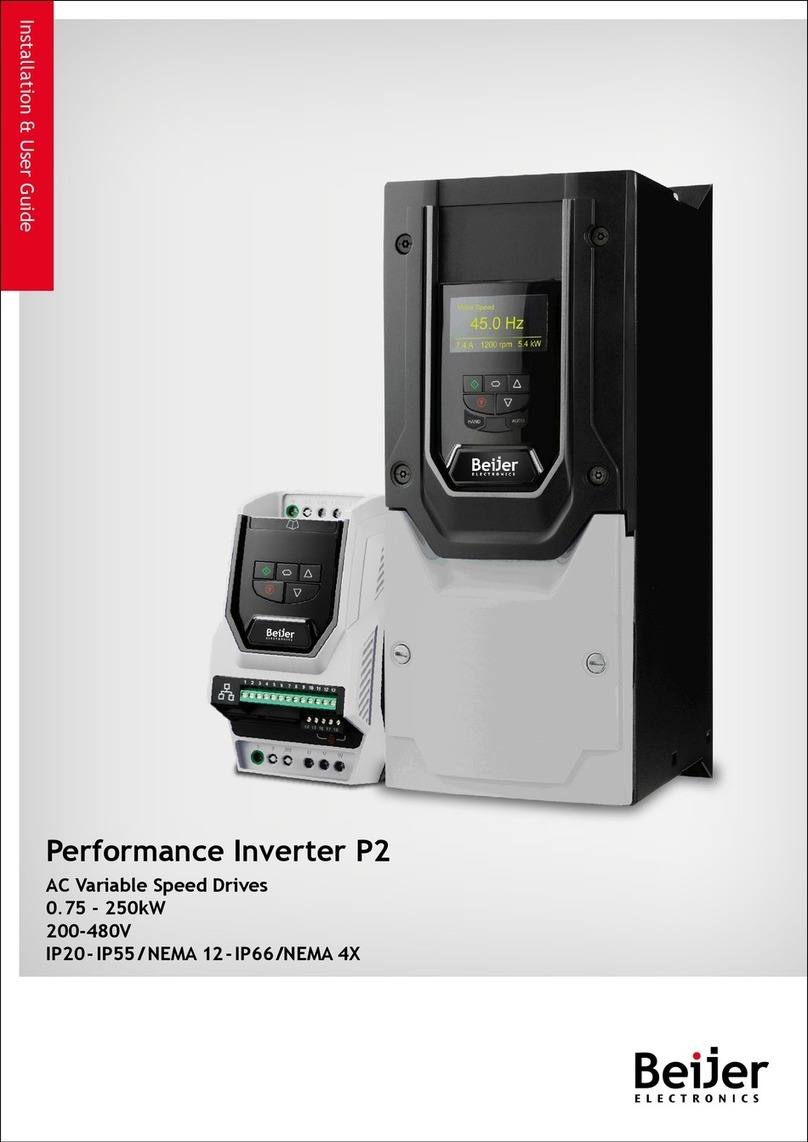
BeiJer
BeiJer BFI-P2 Series Installation & user guide
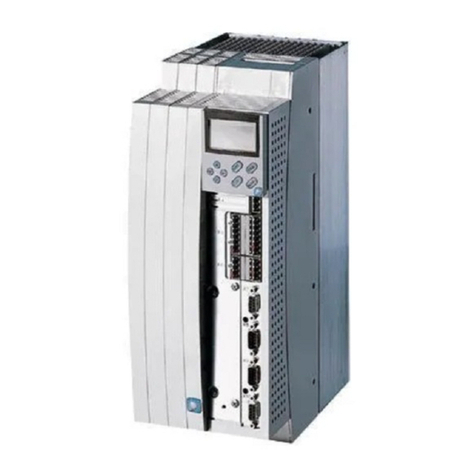
Lenze
Lenze Global Drive 9300 Servo PLC Series Mounting instructions
Acclaim Lighting
Acclaim Lighting Pixel Driver 400 user guide

Parker
Parker Compax3S installation manual
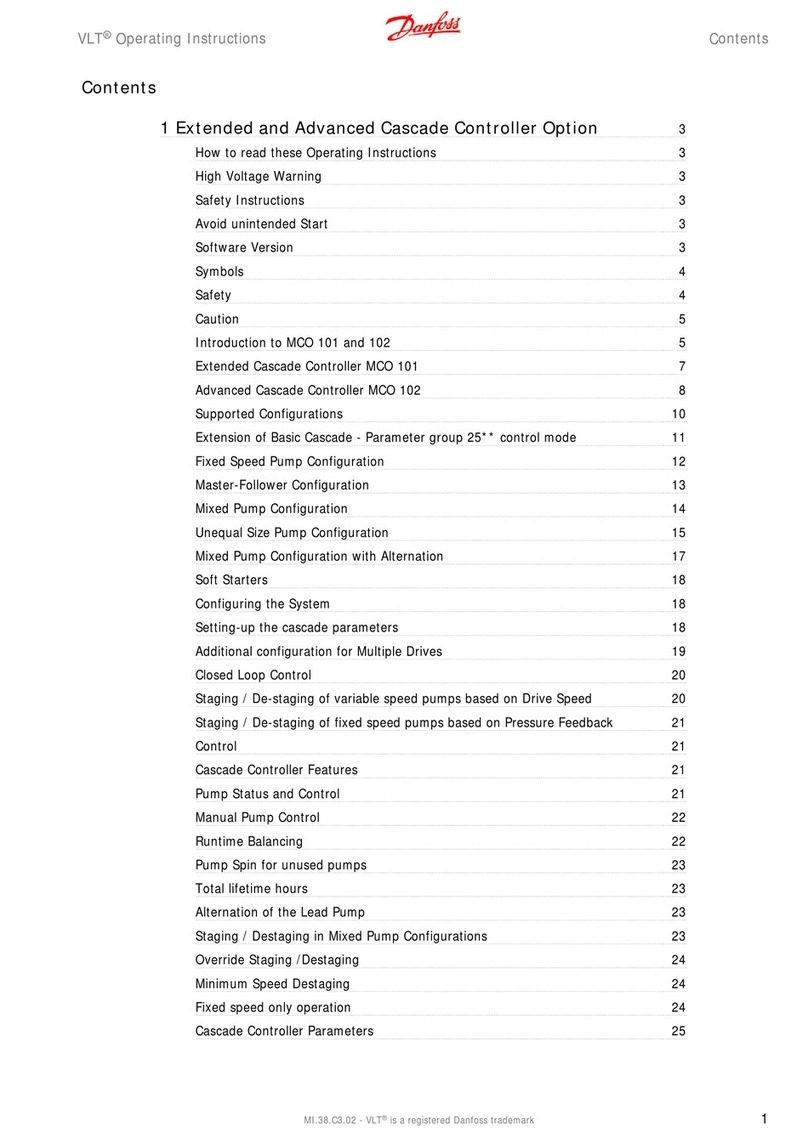
Danfoss
Danfoss VLT series operating instructions
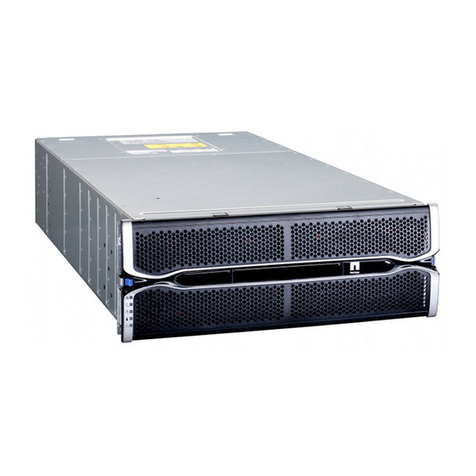
NetApp
NetApp E Series manual
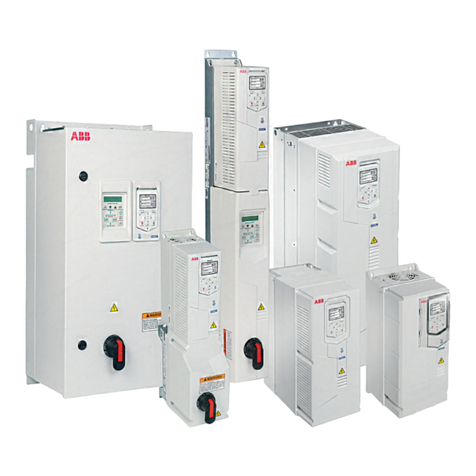
ABB
ABB ACH580-01 Series Installation, operation and maintenance manual

Mitsubishi Electric
Mitsubishi Electric D700-SC Easy start guide
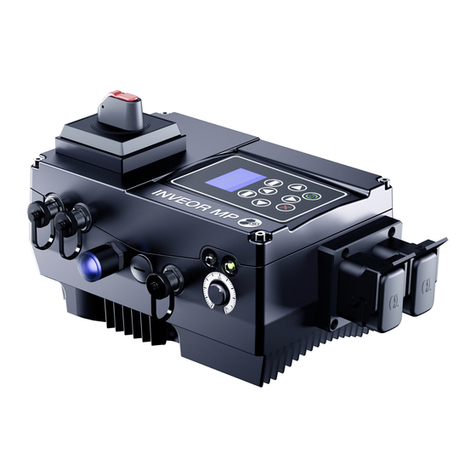
Kostal
Kostal INVEOR M operating manual
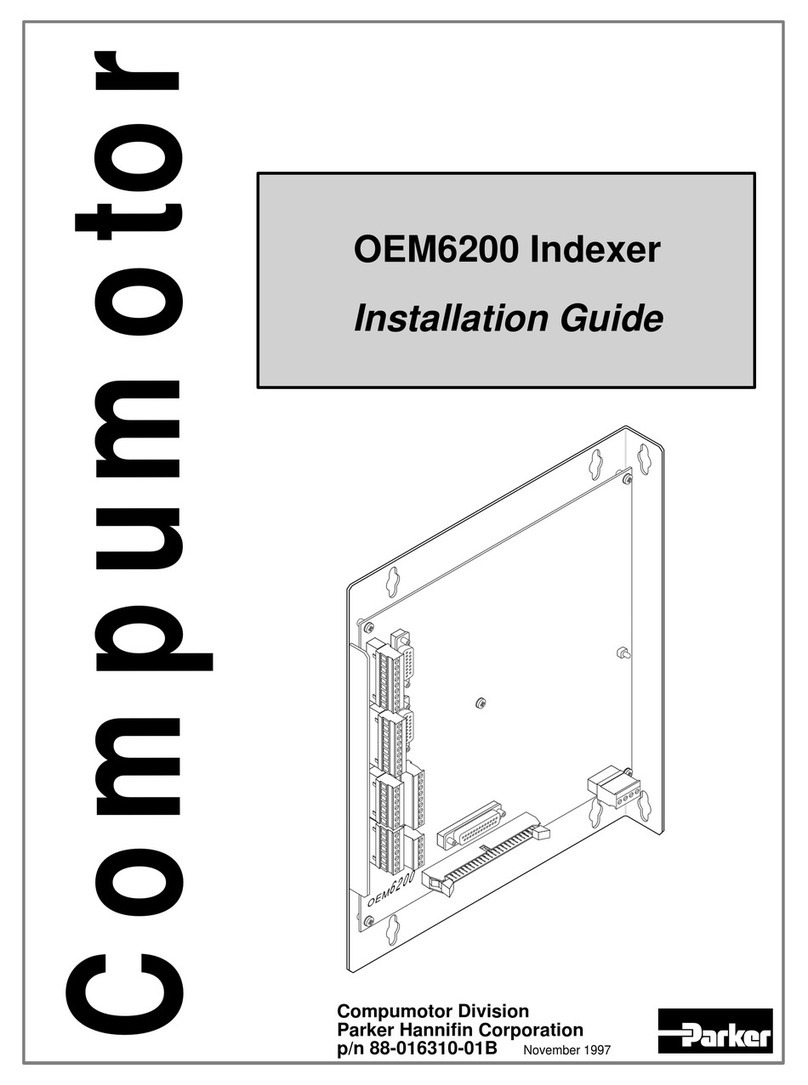
Parker
Parker Compumotor 6000 Series installation guide


